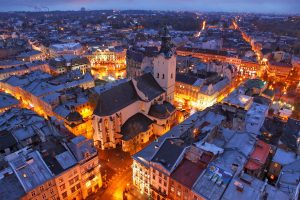Lviv city – study in Ukraine

Formerly capital of the historical region of Galicia, Lviv is now regarded as one of the main cultural centres of today’s Ukraine. The historical heart of Lviv with its old buildings and cobblestone streets has survived Soviet and Nazi occupation during World War II largely unscathed.
The city has many industries and institutions of higher education such as Lviv University and Lviv Polytechnic. Lviv is also a home to many world-class cultural institutions, including a philharmonic orchestra and the famous Lviv Theatre of Opera and Ballet. The historic city centre is on the UNESCO World Heritage List.
Lviv celebrated its 750th anniversary with a son et lumière in the city centre in September 2006. On 12 June 2009 the Ukrainian magazine Focus judged Lviv the best Ukrainian city to live in. Its more Western European flavor has earned it the nickname the “Little Paris of Ukraine”.
Also within Lviv, there are a total of eight institutes of the National Academy of Science of Ukraine and more than forty research institutes. These research institutes include the Centre of Institute for Space Research; the Institute for Condensed Matter Physics; the Institute of Cell Biology; the National Institute of Strategic Studies; the Institute of Neuro-mathematical Simulation in Power Engineering; and the Institute of Ecology of the Carpathians.
The city of Lviv was the location where the software for the Lunokhod programme was developed. The technology for the Venera series probes and the first orbital shuttle Buran were also developed in Lviv. A considerable scientific potential is concentrated in the city: by the number of candidates of sciences, scientific organizations Lviv is the fourth city in Ukraine. Over 100,000 students annually study in more than 50 higher educational establishments.
Lviv’s historic centre has been on the United Nations Educational, Scientific and Cultural Organization (UNESCO) World Heritage list since 1998.
Lviv’s historic churches, buildings and relics date from the 13th century. In recent centuries it was spared some of the invasions and wars that destroyed other Ukrainian cities. Its architecture reflects various European styles and periods.
Lviv’s climate is humid continental (Köppen climate classification Dfb) with cold winters and mild summers. The average temperatures are −3.1 °C (26 °F) in January and 18.3 °C (65 °F) in July. The average annual rainfall is 745 mm (29 in) with the maximum being in summer. Lviv approximately receives 1809 hours of sunshine annually.
According to the World Bank classification Lviv is a middle-income city.
Lviv has 219 large industrial enterprises and almost 9,000 small ventures.
For many years machinery-building and electronics were leading industries in the Lviv. The Lviv-based company Elektron, trademark of national TV-set, produces also 32 and 37 inches liquid-crystal TV-sets. In 2013 Elektrotrans JV starts producing low-floor trams, the first Ukrainian 100% low-floor tramways.
Touristic Areasi in Lviv:
- The Old Town
- Market Square (Ukrainian: Ploshcha Rynok)
- Black House (Ukrainian: Chorna Kamyanytsia)
- Armenian Cathedral
- The complex of the Dormition Church
- The St. Peter and Paul Church of the Jesuit Order
- Korniakt Palace
- Latin Cathedral of the Assumption of Mary
The Lviv tramway now runs about 220 cars on 75 kilometres (47 miles) of track. Previously in bad shape many tracks were reconstructed in 2006 and even more are due to be reconstructed.
The price in February 2011 of a tram/trolleybus ticket was 1.50 UAH (reduced fare ticket was 0.60 UAH, e.g. for students). The ticket may be purchased from the driver.
Modern Lviv remains a hub on which nine railways converge providing local and international services. Lviv railway is one of the oldest in Ukraine. The first train arrived in Lviv on 4 November 1861. The main Lviv Railway Station, designed by Władysław Sadłowski, was built in 1904 and was considered one of the best in Europe from both the architectural and the technical aspects.
The airport is located 6 kilometres (4 miles) from the city centre. In 2012, after renovation, Lviv Airport get new official name Lviv Danylo Halytskyi International Airport (LWO). A new terminal and other improvements worth under a $200 million has been done in preparation for the 2012 UEFA European Football Championship. Public transport from Airport to City Center: Bus No. 48 and 9





